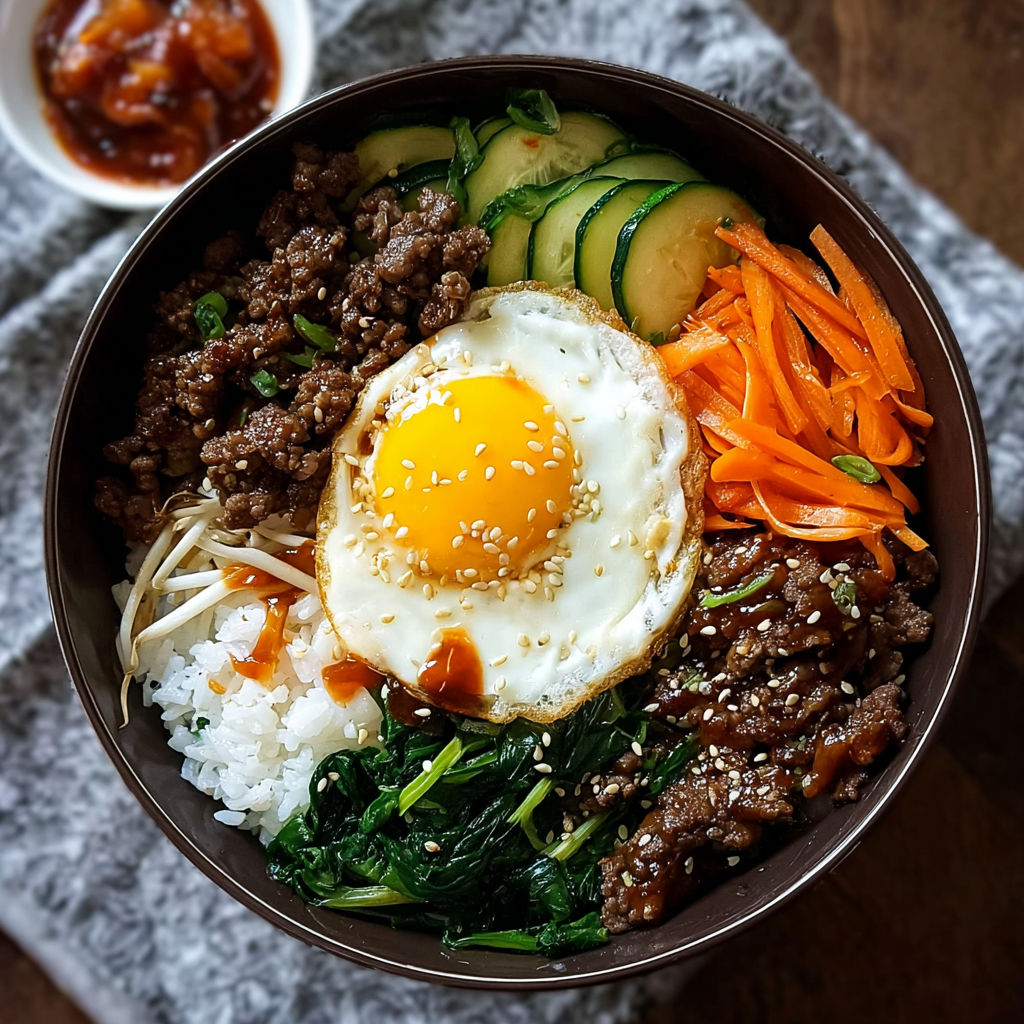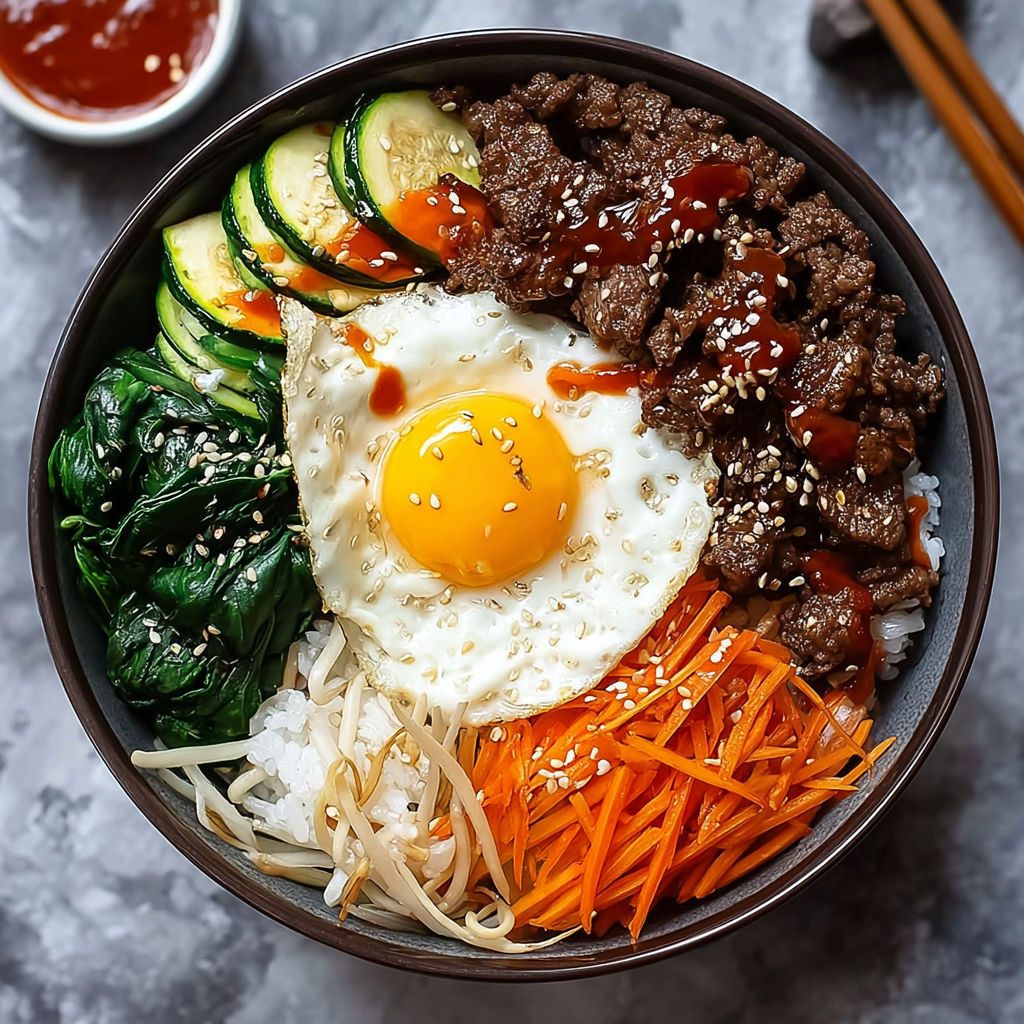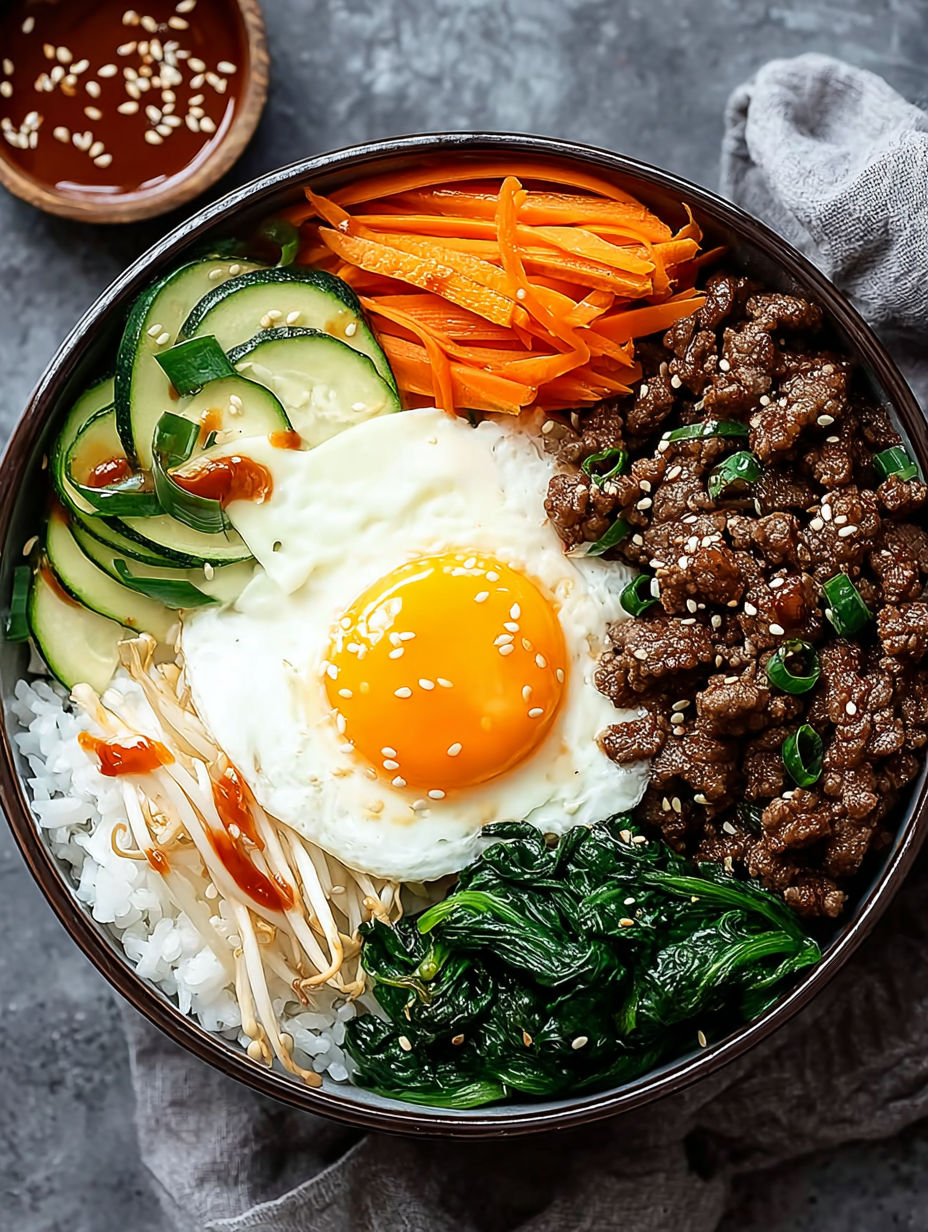 Pin it
Pin it
This colorful Korean beef bibimbap bowl brings real Asian tastes to your home table without much work. The mix of flavored ground beef, bright veggies, and a runny egg makes a full meal that's both healthy and tasty.
I first tried bibimbap during my trip to Seoul and I've spent a lot of time making this easier version at home. Now my family asks for it every week, especially my teens who love adding extra spicy sauce to their own bowls.
- Short grain rice gives you that nice sticky feel that works great with the toppings
- Ground beef makes a cheap and quick protein choice
- Gochujang sauce brings that sweet hot kick that makes Korean food special
- Fresh vegetables add bright colors, good stuff for your body, and crunch
- Sesame oil gives that nutty smell you need in Korean dishes
- Eggs with soft yolks make a natural topping when mixed in
- Low sodium soy sauce gives flavor without too much salt
- Bean sprouts offer a fresh snap that goes well with the hearty beef
Simple Steps For Korean Beef Bibimbap Bowl
- Get the rice going
- Wash short grain rice in cold water until it looks clear to get rid of extra starch. Cook like the bag says, then let it sit covered for 10 minutes after it's done for the best feel. You want rice that sticks together a bit but isn't mushy.
- Cook the meat
- Get a big pan really hot over medium high heat. Throw in ground beef and break it up into tiny bits with a wooden spoon. Let it cook for 5 to 7 minutes until you don't see pink anymore, stirring now and then. Pour off extra fat to make the dish less heavy.
- Add flavor to the beef
- Put gochujang sauce, soy sauce, and sesame oil into the cooked beef. Mix well so all the meat gets coated in the yummy sauce. Turn heat down to low and let it cook slowly for 5 minutes, so the beef soaks up all those good flavors.
- Fix the veggies
- Put a spoon of sesame oil in another pan over medium heat. Cook veggies in small batches, about 2 minutes each until they're just soft but still have some crunch. Add a little salt. Keep each veggie on its own for the classic look.
- Cook the eggs
- In a non-stick pan, warm a bit of oil over medium low heat. Crack eggs gently into the pan and cook until the whites are done but yolks stay runny, about 3 minutes. The soft yolk will make a nice creamy sauce when you mix everything up.
- Put the bowls together
- First put warm rice in each bowl. Put beef and veggies in parts around the edges. Place the egg on top in the middle. Bring extra gochujang sauce to the table so everyone can make theirs as spicy as they want.
The gochujang sauce really makes this dish special. I still remember when my Korean neighbor gave me my first jar of real gochujang, and it totally changed my homemade bibimbap. That deep, sweet-spicy taste can't be copied with other hot sauces, so it's worth looking for at Asian food stores or buying online.
 Pin it
Pin it
Prep Ahead Ideas
You can make all the bibimbap parts 1 or 2 days early and keep them in separate containers. The cooked rice actually gets better after a night in the fridge as it firms up a bit, making it great for warming up. Just heat the rice with a splash of water, warm the beef in a pan, and cook fresh eggs right before eating for a quick dinner.
Mix Up Your Veggies
While old-school bibimbap has certain veggies, this dish works with whatever you have around. Try thin slices of bell peppers, mushrooms, cucumber, or shredded cabbage. The trick is having lots of different colors and textures. I often check my fridge for veggies that need to be used up, which makes this perfect for using everything before your next grocery trip.
The Real Way To Eat It
In Korea, bibimbap comes to your table looking pretty but then gets mixed up before eating. This mixing is actually how the dish got its name – bibimbap means mixed rice. Tell everyone to stir their bowls really well to spread the egg yolk and spicy sauce through all the food for the best taste.
 Pin it
Pin it
Frequently Asked Questions
- → Can I swap the beef for something else?
Definitely! Swap out ground beef with thinly sliced beef, chicken, tofu, or mushrooms for a vegetarian twist. Whatever you pick, make sure to season it well with the spicy gochujang mix to keep the bold flavors intact.
- → What veggies work for bibimbap?
The classics like carrots, spinach, bean sprouts, and zucchini are perfect. But feel free to add mushrooms, cucumbers, bell peppers, kimchi, or any other veggies you love. Go for a mix of colors and textures so every bite is exciting.
- → Do I have to use gochujang?
For the true taste, yes! Gochujang adds the signature sweet heat that makes bibimbap special. If you’re not into spice, tone it down by mixing it with a little honey. No gochujang? Try sriracha and brown sugar mix instead—though it won’t taste quite the same.
- → Can I prep bibimbap ahead of time?
Sure! Cook and store all the components separately in the fridge for up to two days. When you're ready, warm the rice and beef, assemble everything, and top it with a fresh, hot egg before serving.
- → How do I eat bibimbap the right way?
Serve it with the ingredients arranged neatly, then mix it all together when you're ready to eat. The egg yolk and sauce will coat everything perfectly, giving each bite the perfect combo of flavors and textures.
- → What should I pair with bibimbap?
It’s amazing on its own, but you can’t go wrong with kimchi, cucumber salad, or even a simple seaweed soup on the side. Any pickled veggies also work great for a crunchy, fresh bite.
